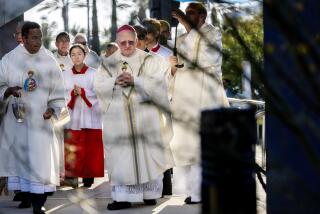O.C. Catholic diocese to buy bankrupt Crystal Cathedral
In the end, 2,000 years of tradition carried the day.
An Orange County bankruptcy judge ruled Thursday that the Crystal Cathedral, a monument to modernism in faith and architecture, will be sold for $57.5 million to the Roman Catholic Diocese of Orange, which plans to consecrate it as a Catholic cathedral.
The ruling was a blow to Chapman University, which had fought bitterly down to the final moments of the bankruptcy case for the right to buy the property as a satellite campus.
It also marked the end of a remarkable chapter in the history of American Christianity, one that was written in glass and steel by the Crystal Cathedralâs founder and guiding light, the Rev. Robert H. Schuller.
In a day filled with drama and deep emotion, Chapman had pressed its case with a newly escalated bid of $59 million, only to complain that it had been blindsided by the Crystal Cathedral board, which came down firmly on the side of the Catholic Church.
In the end, Schuller himself gave his blessing to what once would have seemed unthinkable: the conversion of his sleekly modern masterpiece in Garden Grove, a place where fresh breezes blow through open walls and church services feature talk-show-style interviews, into a Catholic cathedral redolent of incense and ancient ritual.
In a letter to the court, the 85-year-old minister said he could not abide the thought that Chapman might someday use the cathedral for nonreligious purposes. Catholic leaders assured him, he said, that they would âtake on your calling of proclaiming Christâs message to humanityâ and âcare for this campus like the treasure it is.â
U.S. Bankruptcy Court Judge Robert Kwan issued his ruling shortly after 7 p.m. to the tears of members of the cathedralâs congregation, who had sat through the long day in court.
âI only have one word to say and thatâs âdevastated,â â said the Rev. James Richards, who has volunteered at the Crystal Cathedral for 10 years. He said congregants want to continue to worship in their church.
Congregant Bob Canfield said he felt âthrown under the bus.â
Under terms of the bid, the diocese will let the church lease back core buildings for three years, but then it has to find a new home. One possibility is St. Callistus Catholic Church nearby. Chapman had been willing to let the church stay on most of the property for as many as 20 years.
Bishop Tod D. Brown, who has been campaigning for years to build a cathedral, said he was moved, âpainfully so,â by testimony from congregants.
âIâm kind of drained,â he said. âThis is a bittersweet experience. I say this because I have the deepest respect for the Crystal Cathedral ministry.â
Brown also said, without elaborating, that the inside of the cathedral will be renovated to accommodate Catholic worship.
He said that the diocese will pay for the cathedral with loans and the sale of other property, and that the diocese had met all of its obligations from sexual abuse cases. âI donât think we are neglecting victims or victimâs claims,â he said.
James L. Doti, president of Chapman University, said he was disappointed but thought the judgeâs decision was fair. âOftentimes itâs not the way you want it to go,â he said, adding that there are no plans to appeal.
Among the questions is what will happen to the Crystal Cathedral ministry now led by Schullerâs daughter, Sheila Schuller Coleman. The church has been in a downward slide for years, culminating in the Chapter 11 bankruptcy filing in October 2010, when it cited more than $50 million in debt.
The ensuing months saw a lot of on-again, off-again plans by which the church would sell to a real estate developer, the Catholic Church or Chapman, or dig itself out with a âmiracleâ fundraising campaign. The campaign raised only $173,000 by the end of September.
It didnât help that the Schullers appeared tone deaf at times to their own lives of apparent privilege, as when the church recently asked for food donations for Schullerâs ailing wife â and said the items would be delivered to her in a limousine.
âI mean, how out of touch can you possibly be?â asked Richard Flory, director of research in the USC Center for Religion and Civic Culture. âIf youâre part of that congregation, at what point does this person or family start bringing more problems to us as a congregation than benefit?â
That was far from the thinking in 1955, when the church got its start at the Orange Drive-in Theater, where the elder Schuller began preaching his message of âpossibility thinking,â in sync with the skyâs-the-limit optimism of Southern Californiaâs boom years.
Although affiliated with the Reformed Church of America, Schullerâs ministry was a creation unto itself, with a casual style of worship that went down easily among suburbanites. His success led to the popular âHour of Powerâ TV program, which gave him a national pulpit. And it led to the construction, over several decades, of a church campus that is a monument of 20th century modernist architecture.
The cathedral itself was designed by renowned architect Philip Johnson. Surrounding buildings were designed by Richard Neutra and Richard Meier.
Such buildings did not come cheaply â nor did the salaries and perks given to Schuller and his family members. Ultimately, as attendance and TV viewership declined, and contributions dropped, the Schuller empire became unsustainable.
The one bright spot has been its Hispanic Ministry, which is packing two services every Sunday under a charismatic Argentine pastor, Dante Gebel. It is not clear what effect the sale will have on that.
Nor apparently have the Schullers given up. A video went up on the Crystal Cathedral website Thursday in which Schuller Coleman urged congregants not to give up hope in a miracle.
âThere is still time for God to step in and rescue Crystal Cathedral Ministries,â she said.
More to Read
Sign up for Essential California
The most important California stories and recommendations in your inbox every morning.
You may occasionally receive promotional content from the Los Angeles Times.












